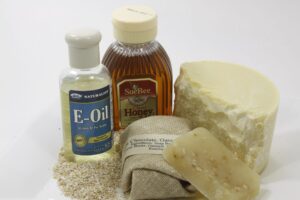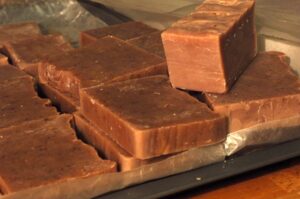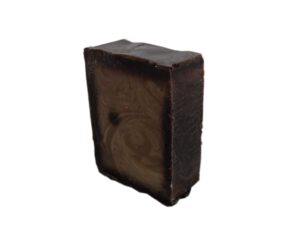While it’s easy to buy at least one version of a plain olive oil soap in most places, soap is expensive. A single bar can set you back $3 to $6, or more. Not only that, but what if olive oil soap isn’t the best option for your skin? Finding other fragrance-free bars can be a challenge. If you make your own soap, you have control over which oils go into it, as well as being able to control scent and other additives. (I’m not going to talk about manufactured additives here, like fragrances, artificial colour, or chemical ingredients like sodium lactate.) Not only that, but a single, inexpensive batch of soap can last you a year or more.
 Recipe Parameters
Recipe Parameters
Start by finding a soap calculator. Here are some options:
- www.soapcalc.net
- Bramble Berry
- The Sage
- The Soap Calculator
- Handcrafted Soap and Cosmetics Guild
- Advanced Soap Calculator
There are even some soap calculator apps!
The soap calculator allows you to set a number of basic parameters and choose your oils and quantities of each. Based on the volume and saponification value of each oil, as well as a few other factors, it calculates the remaining parameters, such as how much lye and water to add. I like to set my fragrance to 0 g and my lye to water ratio at 38%. The amount of water added at the start can be “discounted,” or decreased, with the balance of the water added later in the cook. I will sometimes discount about 20% of the liquid, but I still calculate the recipe based on that whole liquid volume needed.
My superfat is generally set to 5%. This means that I will have 5% more oils than are needed for the reaction. These excess oils will be in the soap to help condition my skin and prevent the soap from being too drying. They also ensure that I don’t have just a little bit too little oil to react with the lye, causing some lye to remain in the soap. Too much excess oil, and the soap won’t clean. In a laundry soap, I would want the superfat percentage to be very close to zero, as the clothing does not benefit from having oil added to it the way skin does.
Ingredients
 You will need a good scale for weighing your lye, oils, and water. I use a kitchen scale with an accuracy of 0.1 grams. I was previously using a scale with an accuracy of 0.5 grams, but it didn’t accurately record small weight additions, so it was very difficult to use with small quantities.
You will need a good scale for weighing your lye, oils, and water. I use a kitchen scale with an accuracy of 0.1 grams. I was previously using a scale with an accuracy of 0.5 grams, but it didn’t accurately record small weight additions, so it was very difficult to use with small quantities.
There are some key ingredients that you will need to make soap. A good, solid soap bar is made using sodium hydroxide (NaOH), otherwise known as lye. This can seem difficult to come by, but it is often either carried in a hardware store’s plumbing department, or is available for them to order in for you. It tends to come in the form of small pellets. Soft or liquid soaps will require potash (potassium hydroxide, or KOH), which is a bit harder to come by. Potash is the chemical traditionally used in medieval times because it can be obtained by running water through wood ash. It is typically purchased in flake form. Both chemicals should be available from soap making suppliers. Both of these ingredients are strong bases, and quite dangerous on their own. When used in the soap making process, they will be completely consumed in the saponification reaction (turning oils into soap); they will not be present in the finished soap.
If you want to design your own recipe, the main control you have over the finished product is the choice of oils. Soap calculators are very important here. The choice of oils used, and amount of each, will affect how well the soap cleanses, how hard the bars of soap are, how much they bubble or lather, and how conditioning they are to the skin. Play and experiment with the calculator. A range of desirable values for each of the calculated factors should be given as a guideline. Start with the oils you already have in your home; I like to put my nearly-expired or already-expired oils in soaps to use them up. Be wary of using olive oil from your kitchen. A lot of olive oils are not entirely what they claim to be and this can unpredictably affect the soap making process. Here are some general guidelines:
- Coconut oil and palm oil will create a very bubbly and cleansing soap – this can be a bit drying.
- Olive oil and hemp oil will create very low-sudsing, gentle soaps. Olive oil can make a very hard soap, but it takes a dry climate and a really long time to harden.
- Cocoa butter tends to make a soap’s lather creamier. It can help raise the INS value and lower the iodine value, and also makes the bar of soap harder.
- Shea butter lowers the iodine value minimally, and lowers the cleansing value slightly, but increases skin conditioning power.
- It can be good to have a mixture of liquid and solid oils. Too many liquid oils can create a very soft bar of soap, and an abundance of very solid oils can lower cleansing and lathering properties considerably, also making the bar hard and brittle. These are just general guidelines; everything depends on the specific oils used.
- Other oils have various other effects. Try them out in the calculator and see how they affect each value.
 With my allergic skin, I tend to try to make bars of soap with no fragrances and low cleansing values; usually a mixture of three to eight oils. These will be the least drying and irritating to my skin. You can buy oils from soap making suppliers like Saffire Blue or from bulk suppliers like Mountain Rose Herbs in the US or New Directions Aromatics In Canada. You can also use grocery store lard/shortening and coconut oil. The range of choices is enormous.
With my allergic skin, I tend to try to make bars of soap with no fragrances and low cleansing values; usually a mixture of three to eight oils. These will be the least drying and irritating to my skin. You can buy oils from soap making suppliers like Saffire Blue or from bulk suppliers like Mountain Rose Herbs in the US or New Directions Aromatics In Canada. You can also use grocery store lard/shortening and coconut oil. The range of choices is enormous.
Each oil will give the soap a different base colour. Lots of shea butter will make the soap a tan colour. Olive and hemp oils add a green tint. Beeswax adds yellow colour. Lard and coconut oil together leave the soap with a pink hue. You can alter these colours with additives.
Additives
Decide if you want to add any additives. Some people add colour to their soaps using mica powders, activated charcoal, or clays, and some add other ingredients like honey or goat’s milk. Some add fragrance (but I’m not going to talk about that here – let’s stick with the safer additives). Other considerations are dry food ingredients like coffee, oatmeal, or cocoa powder. Google the additive to see what percentage is typically used in a soap recipe – they can vary quite a lot. This site also has useful information, but be aware that their instructions for when to add the additive are based on the cold process method (more on that on Monday). If it’s only being used for colour, like a mica powder, you can add in very small amounts (pinch) and blend to see the colour change.
Other Peoples’ Recipes
 If you choose to make soap from a recipe you find on the internet, make sure to confirm it with a soap calculator before making the batch. A small typo can have large consequences on the success or failure of the soap. If you want to try a certain recipe but don’t have one of the ingredients, check through the calculator to see if another oil has similar properties to the oil in the recipe. A substitution may be possible. This page may help. You may also choose to include additives in a recipe you find, or to change additives. The possibilities are nearly endless.
If you choose to make soap from a recipe you find on the internet, make sure to confirm it with a soap calculator before making the batch. A small typo can have large consequences on the success or failure of the soap. If you want to try a certain recipe but don’t have one of the ingredients, check through the calculator to see if another oil has similar properties to the oil in the recipe. A substitution may be possible. This page may help. You may also choose to include additives in a recipe you find, or to change additives. The possibilities are nearly endless.
Now that you’ve chosen all your ingredients, come back Monday to learn what I do to turn them into soap.
